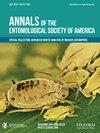铃木果蝇2种蛹寄生蜂的内在竞争(直翅目:果蝇科)
IF 1.8
3区 农林科学
Q1 ENTOMOLOGY
引用次数: 0
摘要
寄主寄生蜂(膜翅目:姬蜂科)和寄生蜂(膜翅目:姬蜂科)对苏氏果蝇有较大的防治潜力;然而,两者都在争夺同样的资源。在本研究中,我们评估了初级寄生蜂的不同发育阶段是否会减少内在竞争的负面影响。为此,我们首先确定了两种寄生蜂各未成熟阶段的持续时间,然后将含有不同发育阶段的第一寄生蜂(vindemiae或T. anastphae)的铃木氏夜蛾蛹提供给第二寄生蜂(vindemiae或T. anastphae)。在不同的发育阶段,我们还比较了第二寄生蜂对第一寄生蜂和未被寄生的铃木氏夜蛾蛹的偏好。研究结果表明,在幼虫发育后期至1龄阶段,猪夜蛾更倾向于寄生未寄生和未寄生过猪夜蛾蛹的幼虫。然而,青肠粉蚧更倾向于寄生于已被青肠粉蚧寄生的蛹。在内在竞争的环境中,除灰瓢虫蛹期被灰瓢虫寄生外,第一个寄生的寄生蜂具有优势。寄生蜂产卵时间的变化减轻了竞争效应;然而,在生物防治中,高寄生性的vindemiae并不具有优势,因为它们会影响原生寄生性的建立,如灰鳞绦虫,并可能成为资源的竞争对手。本文章由计算机程序翻译,如有差异,请以英文原文为准。
Intrinsic competition between 2 pupal parasitoids of Drosophila suzukii (Diptera: Drosophilidae)
The parasitoids Pachycrepoideus vindemmiae Rondani (Hymenoptera: Pteromalidae) and Trichopria anastrephae Costa Lima (Hymenoptera: Diapriidae) have great potential in controlling Drosophila suzukii (Matsumura); however, both, compete for the same resources. In this study, we evaluated whether the different stages of development of the primary parasitoid reduce the negative effect of intrinsic competition. For this, we first defined the duration of each immature stage of both parasitoid species and then offered D. suzukii pupae containing the first parasitoid (P. vindemmiae or T. anastrephae) at different stages of development to the second parasitoid (P. vindemmiae or T. anastrephae). We also checked the second parasitoid's preference (P. vindemmiae or T. anastrephae) for the primary parasitoid at different stages of development (P. vindemmiae or T. anastrephae) or D. suzukii pupae nonparasitized. Our evaluations showed that T. anastrephae preferred to parasitize pupae that were not previously parasitized and that had not parasitized puparia of D. suzukii when P. vindemmiae was in later stage to the 1st instar. However, P. vindemmiae preferred to parasitize pupae previously parasitized by T. anastrephae. In an environment of intrinsic competition, the first parasitoid to parasitize has an advantage, except when the pupal stage of T. anastrephae is parasitized by P. vindemmiae. The variation in the parasitoids' oviposition time mitigates the competition effect; however, for use in biological control programs, the hyperparasitoids P. vindemmiae, does not prove to be advantageous, as they can affect the establishment of primary parasitoids such as T. anastrephae, and can act as competitors for resources.
求助全文
通过发布文献求助,成功后即可免费获取论文全文。
去求助
来源期刊
CiteScore
4.90
自引率
0.00%
发文量
25
审稿时长
6-12 weeks
期刊介绍:
The Annals of the Entomological Society of America exists to stimulate interdisciplinary dialogue across the entomological disciplines and to advance cooperative interaction among diverse groups of entomologists. It seeks to attract and publish cutting-edge research, reviews, collections of articles on a common topic of broad interest, and discussion of topics with national or international importance. We especially welcome articles covering developing areas of research, controversial issues or debate, and topics of importance to society. Manuscripts that are primarily reports of new species, methodology, pest management, or the biology of single species generally will be referred to other journals of the ESA. The most important criteria for acceptance are quality of work and breadth of interest to the readership.

 求助内容:
求助内容: 应助结果提醒方式:
应助结果提醒方式:


